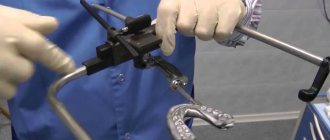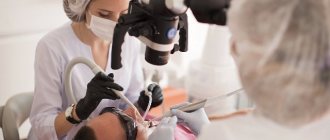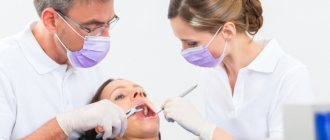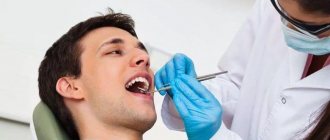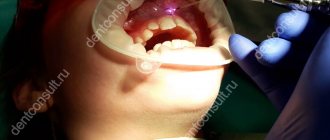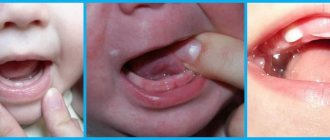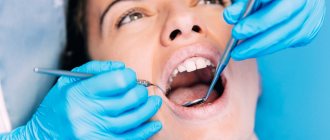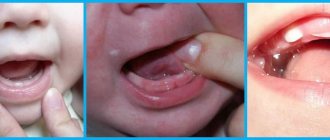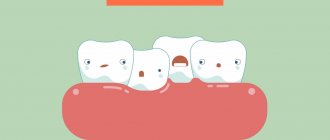Unbearable toothache, sore gums and bad breath require urgent attention from a dentist so as not to aggravate an existing problem.
The initial appointment is carried out by dental therapists. This is a sought-after specialization, since these doctors treat common pathologies of the gums, teeth and oral tissues. A general dentist has a broader range of expertise than a highly specialized orthodontist or surgeon. Such dentists eliminate periodontitis and periodontal disease, relieve pathological changes in the functioning of the salivary glands, treat cheilitis and glossitis (inflammation of the lips and tongue)
A dental therapist not only fills root canals, treats gums or removes tartar. A dentist works to study problems in the maxillofacial area and develop new methods to overcome them.
What diseases does a dentist treat?
At our Dynasty family clinic, dentists practice an individual approach to each patient, depending on the type, origin and dynamics of the disease, and the level of pain threshold.
The main tasks solved by a dentist-therapist:
- Diagnosis and determination of the causes of inflammation, treatment of periodontal disease, periodontitis, periodontoma, gingivitis and periodontitis;
- Treatment and prevention of caries (removal of tartar by the dentist and filling of canals);
- Restoration of mechanical damage to teeth (cracks, chips);
- Elimination of diseases of non-carious origin (pigmentation/erosion or enamel hypoplasia, fluorosis, pulp opening, amelogenesis, root fractures, dentinogenesis, odontogenesis).
At the Dynasty clinic, the dentist-therapist also carries out aesthetic restoration, which allows you to solve all problems within one office, without the involvement of an orthopedist. Without leaving the therapist’s chair, you can restore the front side of the surface of your teeth in two hours using veneers and lumineers (onlays for a “Hollywood smile”) - painlessly, quickly and effectively.
Specialization
Surgeons perform surgical interventions, an orthodontist restores the correct bite using braces and removable or fixed plates, a periodontist treats inflammatory processes in the gums.
An orthopedic dentist is responsible for prosthetics and dental restoration.
Important: All highly specialized doctors work together, since any restoration of the oral cavity requires an integrated approach and comprehensive treatment.
When should you contact a dentist?
Soviet-era people do not like to visit dentists because they are frightened by the strong association with the “scary drill machine” and severe pain. In medical dentistry, therapists use modern methods and equipment to completely anesthetize the process.
A dental therapist will help in cases where:
- During hygienic cleaning of the oral cavity, bleeding is observed;
- The enamel of the teeth has changed shade;
- Eliminates the cause of the unpleasant odor;
- Damage to the oral mucosa requiring intervention by a therapist;
- There is a constant “aching” pain that intensifies when you press on the tooth;
- Carious cavities appeared in the surface of the teeth and they began to react sharply to cold/hot;
- The gums become swollen and red, or new growths appear on them. The dentist will determine the cause of the inflammation and prescribe treatment;
- Teeth receive mechanical damage or have congenital cosmetic defects;
- Constant “wandering” pain radiating to the ear or temple - the help of a dentist is required immediately.
Useful information: It is recommended to visit a dentist twice a year for a routine examination and teeth cleaning with specialized instruments. Using a laser, the dentist removes mineralized deposits on the surface of the teeth, along with pathogenic bacteria. The procedure even allows you to lighten the enamel a little.
Orthopedics as a field of medicine
Orthopedics treats diseases of the musculoskeletal system as a whole. Orthopedists restore spinal curvatures and treat flat feet. An orthopedic dentist eliminates disorders and restores the chewing-speech apparatus. With the help of prosthetics, the doctor restores the integrity of the jaw, which allows a person to chew food normally and communicate with others.
Symptoms
You should consult an orthopedic dentist if:
- absence (loss or removal) of one or more teeth;
- partial or complete destruction of the dental walls;
- mobility or increased sensitivity of teeth;
- diseases of the gums or bones, for example, periodontal disease, periodontitis;
- cosmetic defects in appearance: different size, irregular shape, enamel pigmentation, any other violations in terms of aesthetics;
- detection of temporomandibular joint disease (TMJ);
- recommendations from a therapist or other specialized specialist who issued such a referral after an examination.
Who is an orthopedic dentist and what does he treat?
This specialist specializes in restoring teeth. He is often confused with an orthodontist, however, there is a big difference between these doctors. An orthodontist straightens crooked teeth and corrects problematic bites using braces and removable plates. An orthopedist partially or completely restores teeth using dentures. He is often called a prosthetist.
An orthopedic dentist or prosthetist eliminates many problems, which makes the patients’ lives comfortable and of high quality:
Improves quality of life and restores psychological comfort.
Due to the absence of one or more teeth, the patient loses self-confidence and feels constant discomfort when communicating with others.
Please note : Psychological complexes and stress can also cause pronounced defects in the dentition, for example, large gaps or chips. The person stops smiling widely, speaking openly and constantly controlling the position of his lips. Such tension can provoke the development of side diseases of the nervous system.
Restores chewing function
Chewing food thoroughly is the key to a healthy digestive system. Chewing dysfunction disrupts the functioning of the entire dental system, reduces muscle tone and slows down blood circulation in soft and bone tissues. The faster the doctor fixes the problem, the faster the patient’s general condition will improve. If the situation is neglected, an inflammatory process may develop, which will lead to periodontitis or periodontal disease.
Saves teeth
Let's imagine a situation: a patient came with dental tissue almost destroyed to the ground, which makes it impossible to install a filling, but the roots remained healthy. Common causes are advanced caries or injury. You can try to stop the destruction process by preserving the roots and nerve endings. An orthopedic dentist also deals with such cases.
Treats edentia
Patients who are missing all their teeth also turn to an orthopedist. He makes removable or fixed dentures and places implants that replace natural teeth. This is not just an opportunity to chew, but a complete return of communication skills and a comfortable stay among others.
The medical practice of the orthopedic office includes:
- restoration of tooth enamel and bone tissue while preserving its own root and nerve canals;
- installing a protective crown on a decaying tooth to stop further shedding and delamination of tissue;
- production and installation of prostheses;
- elimination of aesthetic defects in the dentition, such as cracks, chips, irregularities, pigmentation.
Medical protocols are clearly defined, so orthopedic dentists in qualified clinics always follow established rules and treatment regimens. This allows you to avoid negative consequences and dangerous side effects.
What does an orthopedic dentist do?
The area of competence of the prosthetist includes:
Installation of fixed dentures
Such structures include crowns, inlays, and veneers. These designs are securely fixed and are worn constantly.
Metal-ceramic crowns
The most common type of fixed prosthesis. At the base is a cap made of an alloy of cobalt, chromium and titanium, which is coated with a ceramic composition. This design imitates healthy teeth, lasts from 5 to 10 years and is quite affordable. Safety depends on the presence of impurities in the material, which can cause oxidation and inflammation of the gums.
Zirconium dioxide crowns
One of the most advanced techniques. The cap, shaped like a tooth, is made of zirconium dioxide, which is covered with ceramic on top.
This material does not cause allergic or oxidative reactions. It does not interact in any way with the soft tissues of the gums. When making prosthetics, computer modeling is used, which creates a crown of the most accurate shape and size. The number of possible shades is much greater compared to conventional metal ceramics, so the artificial tooth will not stand out among the natural dentition.
Solid ceramic crowns
There is no metal in such designs, which allows you to fully convey all the shades of the tooth. These crowns are placed on the front teeth.
Installation of removable dentures
Clasp prosthetics are suitable for cases where it is impossible to install fixed structures, and the patient does not have money for implantation. It is an arch with two supports that hold artificial teeth. The orthopedist fixes it to the upper jaw.
The undoubted advantages of clasp dentures are low prices and the absence of surgical intervention. There are quite a lot of disadvantages. Firstly, it takes a long time to get used to the prosthesis. Secondly, it must be removed and cleaned daily. Thirdly, the jaw does not receive full load when chewing food, the blood supply deteriorates and the bone gradually sags. Therefore, removable dentures need to be changed quite often.
Implantation
This is the method that doctors recommend to all patients who have lost one or more teeth. Implants not only maintain a beautiful appearance, but also contribute to the health of the patient.
Regardless of the chosen method of prosthetics, all installed structures must be:
- made taking into account the individual characteristics of the patient;
- designed for long term use;
- safe for health and solve aesthetic problems.
An integrated approach to treatment
Let us once again emphasize the important connection between the orthopedist and other specialized doctors. First, the therapist sanitizes the oral cavity, removes plaque and stones, and treats inflammatory processes in the gums and oral mucosa.
Surgeons remove the roots of teeth that are no longer subject to therapeutic treatment and implant an implant into the patient’s jaw for further manipulation by an orthopedist.
The orthopedic dentist works closely with dental technicians who are responsible for making dentures in the laboratory.
Patient reviews will help you choose a competent orthopedic dentist. It is important to establish complete trust and mutual understanding between the doctor and the patient. Your health and beautiful smile largely depend on this.
Cost of dental services
The dentist provides a wide range of services, so prices depend on many factors: the type of disease and the complexity of its treatment; consumables and number of sessions with the dentist.
Basic cost of services:
- Professional cleaning – 170 rubles;
- Treatment of pulpitis and periodontitis – from 550 rubles;
- Elimination of caries – from 300 rubles;
- Chemical whitening of all teeth – 8,000 rubles.
The full list is in the price list on the website.
If you need professional dental help, our clinic offers the services of specialists with many years of experience.
How is the appointment going?
Like any other specialist, a dental surgeon first of all listens to patients’ complaints and collects anamnesis. He must know everything related to the problem that worries the patient. Then it’s time for a visual inspection. The doctor examines the problem area, and he can use tools such as a dental mirror, spatula, probe and others.
Using light tapping, the doctor identifies the area that is causing pain. If we are talking about soft tissues, palpation is performed. The doctor pays attention to swelling, redness, altered areas of the skin and mucous membranes, as well as the patient’s appearance. How the examination will be carried out directly depends on the specific case.
Useful recommendations for oral care from a dentist
The dentist promotes caries prevention and gives basic advice:
- Maintain good hygiene (brush your teeth after eating and floss);
- When brushing, do not forget about your tongue, because germs accumulate on it first;
- Limit your consumption of carbonated and coloring drinks, chips, candies and candies;
- Get a preventive examination at the dentist.
A dental therapist is able to prevent diseases and treat them at an early stage, which will help avoid many problems.
To make an appointment, call the phone numbers listed on the website or use the feedback form.
Treatment methods
Surgical dentistry provides a wide range of treatments, which include special methods of surgical influence on the tissues of the oral cavity. The specific choice of treatment method depends on the disease. This section of dentistry practices the following treatment methods:
- bone grafting;
- tooth extraction operations;
- aesthetic surgical operations;
- implantation;
- prosthetics;
- resection of soft tissues.
After surgery, anti-inflammatory, antihistamine, antiprotozoal and antibacterial drugs may be prescribed. If pain is present, anesthetics are indicated.
Prices for tooth extraction
| Name | Price |
| Consultation | For free |
| Use of bone material | 4,000 rub. |
| Simple tooth extraction | 2,700 rub. |
| Removal of periodontitis tooth | 1,000 rub. |
| Tooth extraction is complicated | 3,200 rub. |
| Removal of a dystopic wisdom tooth | 4,000 rub. |
| Removing a tooth fragment | 500 rub. |
| Removal of exostosis in the area of 1 tooth | 2,500 rub. |
| Removal of cysts and benign formations | 3,500 rub. |
| Treatment of alveolitis | 1,200 rub. |
| Lengthening the clinical crown of a tooth | 5,000 rub. |
| Free flap gum grafting | 8,000 rub. |
| Removing stones from the ducts of the salivary glands | 3,500 rub. |
| Splinting for a jaw fracture | 15,000 rub. |
| Socket curettage | 200 rub. |
| Filling the hole with a medicinal substance (Alvogil, al-vostaz, hemostatic sponge) | 200 rub. |
| Resection of the apex of the tooth root | 4,500 rub. |
| Removing a foreign body from the canal | 1,500 rub. |
How is sedation different from anesthesia?
Sedation
– this is depression (suppression) of consciousness to the level of relaxation. At the same time, all protective reflexes are preserved, for example, a blood clot entering the respiratory tract will cause a coughing attack. Sedation reduces the level of reactions, but does not block pain receptors; local anesthesia is used for this.
Anesthesia
causes complete loss of consciousness, so it requires monitoring of all vital functions. General anesthesia turns off pain receptors; no additional pain relief is needed.
The term “sedation” has not taken root in general use, and simple relaxation is often also called anesthesia. It is worth remembering that tooth extraction under general anesthesia is used extremely rarely, mainly in hospitals. This requires a specially equipped operating room, everything necessary for resuscitation, and a qualified anesthesiologist must carry out the procedure.
Therefore, if you are offered to have a tooth removed under anesthesia, clarify what is meant: anesthesia or sedation.
Related materials:
dentist | Givenchy | SEPHORA COLLECTION | Dior | Givenchy | Sephora | Dior | teeth | white teeth | smile | beautiful smile | prosthesis | surgery
Articles
- In the know: fall makeup trends August 29, 2015, 00:00
- Virtual Stylist: The Most Stylish Apps December 17, 2022, 00:00
- Pastel makeup: making accents January 25, 2022, 00:00
Video
- New birth of four-color shadows from Givenchy September 15, 2010, 00:00
- Little tricks for a dazzling smile from Givenchy October 20, 2010, 00:00
- Beauty in Korean October 24, 2016, 12:00
Orthodontic devices for bite treatment
Orthodontic systems are created or customized to address a patient's specific problems. When installed on the teeth, the corrective system begins to put pressure on abnormally located areas, forcing:
- teeth move into the correct position;
- dental rows expand to anatomically correct sizes;
- muscles tighten, returning them activity and strength.
When choosing a device for treatment, an experienced orthodontist will take into account the absence of certain restrictions. Correction of anomalies is possible in the following cases:
- the teeth experience sufficient pressure to move into the desired position;
- the orthodontic apparatus is well fixed and supported;
- the dentofacial row is prepared - there is a place where the tooth that can be moved or rotated will fit;
- the tooth being moved has no obstacles to movement.
The main structures for correcting malocclusion used by an orthodontist:
- plates are mainly removable systems that help move teeth and expand the jaw to the desired size;
- trainers - silicone products for high-quality fixation of the position of the tongue and teeth, helping the teeth of the permanent bite to grow correctly and solving a number of other orthodontic problems;
- aligners are individually created aligners that are invisible on the teeth and can quickly move incorrectly positioned teeth to anatomically correct points;
- braces are non-removable orthodontic systems for high-quality correction of any malocclusion.
Rodikova Tatyana
Today, braces and aligners are competitors. Many parents ask for aligners for their children, since they are practically invisible on the teeth. Unfortunately, aligners do not cope with all malocclusions, but if possible, then, of course, I will agree with the patient’s wishes.
What does an orthodontist treat in children?
The list of orthodontic diseases, pathologies and anomalies is extensive. These are not only bite defects, but also many other deviations - congenital, hereditary, acquired. The most common problems people come to dentistry for are:
- teeth;
- dentofacial rows;
- bite
Pathologies and dental anomalies
When assessing individual units of a child’s jaws, a pediatric dentist or orthodontist will pay attention to the developmental features of each individual tooth:
- shape - classic or spiky, screwdriver-shaped, barrel-shaped, with deformations of the cutting edge line;
- dimensions - reduced or increased compared to neighboring units;
- tissue structure - normal teeth, underdeveloped condition, excess tissue volume;
- timing of appearance - according to the age of the child, early eruption or late;
- position in the jaw row - rotated, tooth growth from the side of the lip or from the side of the palate, excessive protrusion from the gums, growth in place of another tooth.
Also, the pediatric orthodontist will note the number of teeth in a row - edentulism or the presence of supernumerary teeth.
Almost all of the problems listed are solvable. Modern dental methods can quickly and painlessly change the positions of teeth, reverse pathologically located units, help quickly remove excess teeth and perform prosthetics in the absence.
Anomalies of the dentition
What does the pediatric orthodontist treat in this case? Problems of the dentition are more serious for dental health than single anomalies of growing units. Incorrect position of the jaws affects the quality of speech, creates difficulties in nutrition, and worsens the aesthetics of the face.
The most common problems relate to:
- The size of the jaw rows is excessive growth of one of the jaws compared to the second or a delay in development in both rows.
- The position of the jaw relative to the base of the skull is asymmetry, forward or backward displacement.
- Consistency and symmetry of the arrangement of teeth - poor contact when closing, crowding, rare position, large gaps between units.
Anomalies of bite, occlusion
Pathological bite is the most common problem among young patients. The orthodontist will successfully correct the bite
- distal - the upper dental row is highly developed and protrudes forward;
- mesial - excessive development of the lower jaw is observed;
- cross - when the teeth are closed, the upper dental row intersects with the lower one;
- deep - the upper incisors completely cover the lower ones;
- open - the teeth are only partially connected.
There are many pathologies, and the doctor’s task is to make the correct diagnosis and select the correct treatment.
Pediatric dentistry: how an orthodontist treats
A pediatric orthodontist chooses a treatment method only after a complete examination of the patient. When making a decision, the doctor takes into account:
- child's age;
- type of bite - milk, permanent, replaceable;
- orthodontic pathology - anomalies of teeth, dentition, bite.
The most popular correction methods:
- myogymnastics (myotherapy) - a course of special exercises aimed at strengthening the muscles of the maxillofacial area;
- surgical method - necessary to eliminate pronounced deformations of the bite, jaw rows, dental sequences;
- hardware therapy - the use of fixed and removable structures to correct the bite or individual units.
Endodontic dental treatment: when and how is it carried out?
Endodontic dental treatment is used in practice if caries has destroyed the tooth and the inflammatory process has moved into the canals of the dental unit. When carrying out endodontic dental treatment, a specialist treats the canals: cleans the cavities from damaged tissue, rinses them with an antiseptic solution, and applies medicine. Typically, after these procedures, a temporary filling is placed on the tooth, and the patient is sent home to return to the dentist's office in a few days.
At the second visit, an x-ray of the diseased tooth is taken to evaluate the effectiveness of the treatment. If the inflammation has been stopped, the canals are treated with an antiseptic again, and then their space is filled with gutta-percha. The tooth treatment ends with the final restoration of the crown using a composite filling material.
Endodontic treatment must be carried out with high quality and using specialized modern tools: files that allow the canals to be expanded as needed, a microscope that allows the doctor to see the condition of the tissues and canals, an apex locator that shows the length of the tooth canals.
If root canal treatment is carried out incorrectly, errors are made in its technology - there are risks of serious complications that can lead to the loss of a dental unit.
What could go wrong
The vast majority of complications are caused by doctor error. The incompetence of an anesthesiologist entails:
- Problems with the respiratory system
. Mucus and blood clots can get into the airways and block them, since during general anesthesia protective reflexes are suppressed. - Problems with the cardiovascular system
. The wrong dosage causes different reactions: a slowdown or acceleration of the heart rate, a drop or increase in blood pressure.
Recovery from anesthesia may be accompanied by nausea, vomiting, and inappropriate behavior. General anesthesia is a serious shock to the body; it should not be considered harmless.
There are fewer risks with sedation
, but they exist too. These are all the same breathing disorders and hemodynamic processes (problems with blood pressure and heart rate).
Which colleagues does the prosthetist interact with?
The implementation of any of the techniques used by an orthopedic dentist is impossible without close interaction with other specialists. An integrated approach to restoration and prosthetics is carried out with the contribution of the following doctors to the common cause:
- Dentist-therapist
. Performs preparatory work prior to prosthetics - carries out sanitation of the oral cavity, removes dental deposits (plaque and tartar), and treats diseases of the mucous membrane and periodontium. - Dentist-surgeon
. At the preparation stage, it removes teeth and non-viable roots in cases where the problem cannot be treated therapeutically. At the stage of prosthetics, implants are implanted into the jaw, on which the orthopedist later carries out the final stage of restoration of the dentition. - Dental Technician
. This specialist uses impressions made by an orthopedist to make the necessary prosthetics and orthopedic structures. If necessary, after fitting the patient, he also adjusts the created prostheses, correcting possible shortcomings that cause discomfort to the patient. - Anesthesiologist (or resuscitator)
. Interaction with this colleague is necessary when, with complete edentia, it is necessary to place many implants on both jaws. This procedure may require general rather than local anesthesia. - Dentist-orthodontist
. If prosthetics are to be installed, and the patient has problems with the bite, then the treatment plan includes the need to contact this particular specialist. After complete treatment, you can begin preparing and installing prostheses.
When planning prosthetics, be prepared for the fact that a comprehensive solution to the problem will be required. This means that in addition to the orthopedic dentist, you will have to visit a number of highly specialized specialists.
Features of complex extraction
First, the doctor conducts a visual examination and palpation, studies x-rays and uses them to assess the condition of the bone tissue and periodontal tissue. Only after a thorough examination of all aspects of the clinical picture can a specialist make a final verdict. Based on the same X-ray image, he determines the number of roots, the shape and depth of their occurrence, and assesses the complexity of the work ahead.
Further, the procedure in most cases is carried out according to the following scheme:
- the surgeon makes an incision on the mucosa to provide direct access to the cervical area,
- if it is necessary to separate the teeth, the doctor saws the crown and root system, after which he literally saws it out of the bone tissue in order to remove the tooth in parts,
- then he lowers special forceps to the very edge of the alveolus, clamps the instrument, fixes it and, carefully twisting or rocking the tooth, removes it from the socket,
- the flap of tissue is returned to its place and sutures are applied.
Complex tooth extraction is a full-fledged operation.
As mentioned above, the procedure can be performed both under local anesthesia and with additional deep sedation. And only in exceptional cases is the use of general anesthesia allowed.
Problems solved by orthopedic dentistry
To understand who an orthopedic dentist is, you need to know more about the field of medicine in which this doctor works. The main tasks that orthopedic dentistry solves are:
- restoration of dentition;
- elimination of chewing function disorders;
- installation of prostheses, as well as regulating and replacement devices;
- diagnosis, prevention and treatment of speech apparatus deficiencies;
- therapy of jaw diseases using specialized devices and structures.
The efforts of specialists working in this field are aimed at eliminating most defects in the dentition and achieving maximum aesthetics of the result (taking into account the functional component).
Features of the dental treatment process under a crown
Installing a crown does not guarantee 100% protection of the tooth from caries and other dental diseases. Some time after the installation of a prosthetic structure in the patient’s oral cavity, phenomena such as subsidence of the gums and exposure of the cervical part of the tooth may be observed. These phenomena create favorable conditions for the development of caries and the risks of developing carious lesions are especially high due to insufficient oral hygiene. Under the crown, not only caries can develop, but also pulpitis and periodontitis, and therefore if you have pain in a tooth on which a crown has been placed, you need to seek professional treatment urgently!
If the diagnosis reveals caries or an inflammatory process under the crown, tooth treatment will involve removing the orthopedic structure and carrying out all the necessary manipulations to stop the inflammation and save the tooth.
Note that caries under the crown often appears because errors were made during the manufacture of the prosthetic structure or during its installation. If the crown is adjacent to natural tissues with insufficient density, pathogenic microflora can easily penetrate under it. For this reason, it is important to choose a good dental clinic for prosthetics, which employs experienced and competent specialists.

